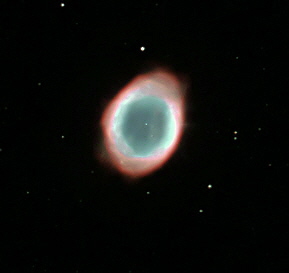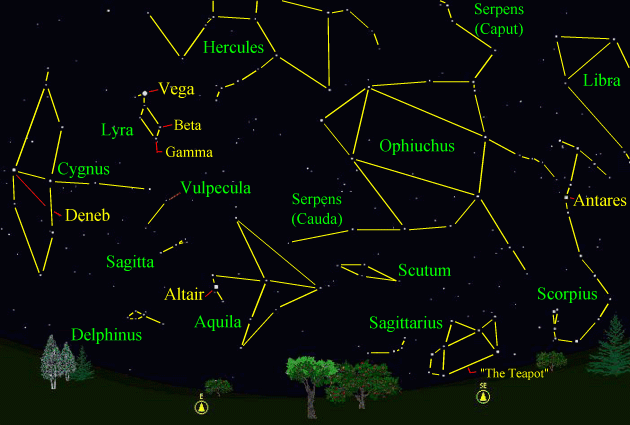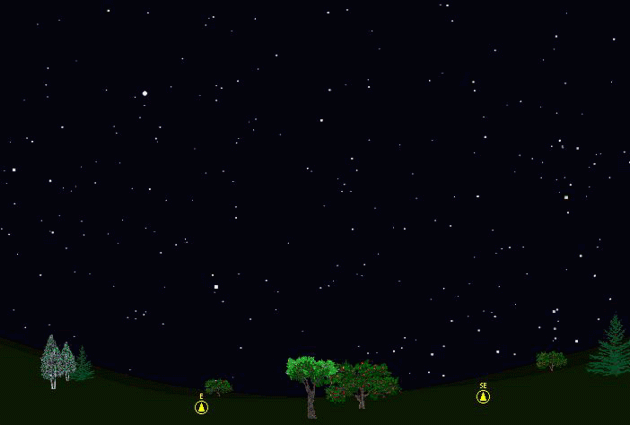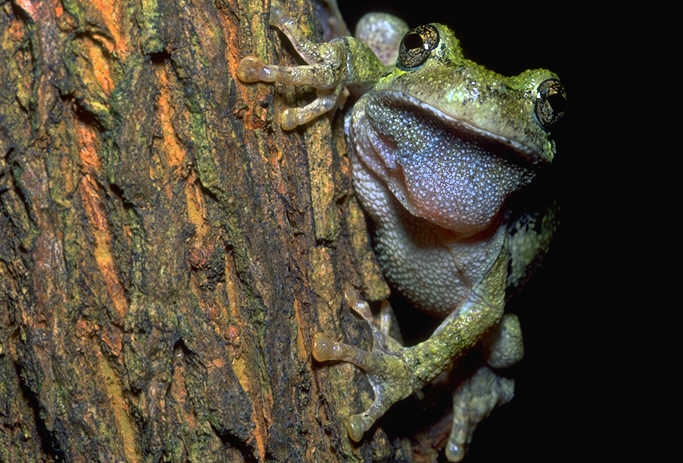The purpose of this feature is to give scout leaders, educators and naturalists an idea of some of the natural events coming up each month. We will try to cover a variety of natural events ranging from sky events to calling periods of amphibians, bird and mammal watching tips, prominent wildflowers and anything else that comes to mind. We will also note prominent constellations appearing over the eastern horizon at mid-evening each month for our area for those who would like to learn the constellations. If you have suggestions for other types of natural information you would like to see added to this calendar, let us know! Note: You can click on the hyperlinks to learn more about some of the featured items. To return to the Calendar, hit the "back" button on your browser, NOT the "back" button on the web page. All charts are available in a "printer friendly" mode, with black stars on a white background. Left clicking on each chart will take you to a printable black and white image.
Notes and Images From May 2008
They have been called the funeral wreaths nature places around dying stars. A planetary nebula forms after a medium or low mass star depletes its supply of hydrogen fuel. In the process of reconfiguring itself to burn helium, the star becomes a red giant. After spending a billion years or so in the red giant phase, the star casts off its outer layers, which form a shell of glowing gas and plasma illuminated by what's left of the central star. This central star, now a white dwarf, is visible in the image at right. It is destined to slowly cool over billions of years into a black cinder. This will be the eventual fate of our sun. Planetary nebulae were so named because early observers thought the small round nebulae resembled faint planets like Uranus. Messier 57, the Ring Nebula, is one of the brightest planetary nebulae in the sky and can be found in the constellation of Lyra (see the sky chart below.) Look for it a little over half way from Gamma Lyrae to Beta Lyrae, along a direct line between those two stars. Although you can find it in a 2" aperture telescope, you will need at least a 3" scope to see the annular form. A 6" aperture telescope will give you a much better view, and the nebula looks like a small ghostly doughnut. Since the human eye does not see color well at low light levels, visually the nebula appears grayish or grayish-green. The Ring Nebula is 2300 light-years away and, though the central star appears faint, it is actually about 200 times more luminous than our sun. Spotting it visually requires at least a 12" aperture telescope and good seeing conditions.
Sky Events for June 2008: The Sun arrives at the summer solstice at 6:59 CDT on June 20th, marking the beginning of summer in the Northern Hemisphere. This is the first time since 1896 that the June solstice has arrived as early as June 20th in Universal Time. Evening Sky: Mars now has faded to magnitude 1.5, and can be found at mid-month about 22 degrees above the western horizon at dusk. Above and to the left of it look for Saturn and the bright star Regulus. Both planets are in Leo. Jupiter rises about 9:40pm at mid-month in Sagittarius. The waxing crescent Moon is only 2 degrees below Mars on the evening of June 7th, and on the 8th it forms a pretty grouping with Saturn and Regulus. All times noted in the Sky Events are for Franklin, Tennessee and are Central Daylight Time. These times should be pretty close anywhere in the mid-state area.
Constellations: The views below show the sky looking east at 9:30pm CDT on June 20th. The first view shows the sky with the constellation outlined and names depicted. Star and planet names are in yellow. Constellation names are in green. The second view shows the same scene without labels. New constellations this month in the eastern sky are Cygnus, the Swan, with its bright star Deneb, and Aquila, the Eagle, with its bright star Altair. The bright stars Deneb, Altair and Vega form the "Summer Triangle." If you locate them first, you will have an easier time finding the constellations around them. Below and to the left of Altair is the constellation of Delphinus, the Dolphin, looking like it's leaping over the eastern horizon. Above Delphinus look for the arrow-like form of Sagitta, the Arrow. Between Sagitta and Cygnus lie the faint stars of Vulpecula, the Fox. Easier to spot are the brightest stars of Sagittarius, the Archer, which form a grouping nicknamed, "The Teapot." Look for them just above the southeast horizon. "The Teapot" will become easier to see as it rises higher above the horizon. On very clear summer nights the bright portions of the Milky Way above Sagittarius look like steam rising from the spout of the teapot. If you look just to the right of the spout of the teapot, you will be looking in the direction of the center of our galaxy. The little grouping of stars to the left of Sagittarius is nicknamed, "The Teaspoon." All of the constellation Scorpius, the Scorpion, with its bright star Antares, should now be above the horizon in the southeast. Also in the southeast and above Sagittarius, look for the faint stars of Scutum.
On Learning the Constellations: We advise learning a few constellations each month, and then following them through the seasons. Once you associate a particular constellation coming over the eastern horizon at a certain time of year, you may start thinking about it like an old friend, looking forward to its arrival each season. The stars in the evening scene above, for instance, will always be in the same place relative to the horizon at the same time and date each June. Of course, the planets do move slowly through the constellations, but with practice you will learn to identify them from their appearance. In particular, learn the brightest stars (like Altair and Vega in the above scene looking east), for they will guide you to the fainter stars. Once you can locate the more prominent constellations, you can "branch out" to other constellations around them. It may take you a little while to get a sense of scale, to translate what you see on the computer screen or what you see on the page of a book to what you see in the sky. Look for patterns, like the stars that make up the constellation Lyra. The earth's rotation causes the constellations to appear to move across the sky just as the sun and the moon appear to do. If you go outside earlier than the time shown on the charts, the constellations will be lower to the eastern horizon. If you observe later, they will have climbed higher. As each season progresses, the earth's motion around the sun causes the constellations to appear a little farther towards the west each night for any given time of night. If you want to see where the constellations in the above figures will be on July 20th at 9:30pm CDT, you can stay up till 11:30pm CDT on June 20th and get a preview. The westward motion of the constellations is equivalent to two hours per month. Sky Publishing has just come out with a beautiful and compact star atlas, Sky & Telescope's Pocket Star Atlas. It is destined to become a classic, and is a joy to use at the telescope. A good book to learn the constellations is Patterns in the Sky, by Hewitt-White. You may also want to check out at H. A. Rey's classic, The Stars, A New Way to See Them. Another good book, at $34.95 a little more expensive but with many great features, is A Constellation Album, by P. K. Chen. It has beautiful photos of the night sky with clear overlays that show the traditional constellation outlines. For skywatching tips, an inexpensive good guide is Secrets of Stargazing, by Becky Ramotowski. A good general reference book on astronomy is the Peterson
Field Guide,
A Field Guide to the Stars and Planets, by Pasachoff.
The book retails for around $14.00. Starry Night has several software programs for learning the night sky. Visit the Starry Night web site at www.starrynight.com for details.
Amphibians:
In June the treefrogs really hit their stride. Listen for Cope's Gray Treefrogs, Gray Treefrogs, Bird-Voiced Treefrogs, Green Treefrogs and Barking Treefrogs. Northern Cricket Frogs and Southern Cricket Frogs call a lot during June, and the calls of Bullfrogs and Green Frogs fill the night air. After heavy rains listen for the high, insect-like call of the Eastern Narrowmouth Toad and the strange-sounding Eastern Spadefoot.
Birds: Now is a good time to get to know the breeding birds of Tennessee. It's fun to take a trip to the Great Smoky Mountains National Park in June and hike a high altitude trail, like the Alum Cave Bluff trail. By doing so you can encounter birds that breed in Tennessee at these higher elevations, like Black-throated Blue Warblers, Canada Warblers, Chestnut-sided Warblers and Blackburnian Warblers. Recommended: Bird Finding in Tennessee, Michael Lee Bierly. A classic guide to finding birds in Tennessee. The Sibley Guide to Birds, David Allen Sibley The Sibley Guide to Birds of Eastern North America, David Allen Sibley An inexpensive guide for beginners is the Golden Guide for Birds.
Archives (Remember to use the back button on your browser, NOT the back button on the web page!)
Natural Calendar February 2008 Natural Calendar December 2007 Natural Calendar November 2007 Natural Calendar September 2007 Natural Calendar February 2007 Natural Calendar December 2006 Natural Calendar November 2006 Natural Calendar September 2006 Natural Calendar February 2006
Natural Calendar
December 2005
Natural Calendar
November 2005
Natural Calendar
September 2005
Natural Calendar
February 2005
Natural Calendar
December 2004
Natural Calendar
November 2004
Natural Calendar
September 2004
Natural Calendar
February 2004
Natural Calendar
December 2003
Natural Calendar
November 2003
Natural Calendar
September 2003 Natural Calendar February 2003 Natural Calendar December 2002 Natural Calendar November 2002 Nature Notes Archives: Nature Notes was a page we published in 2001 and 2002 containing our observations about everything from the northern lights display of November 2001 to frog and salamander egg masses. Night scenes prepared with Starry Night Pro software All images and recordings © 2008 Leaps
|



